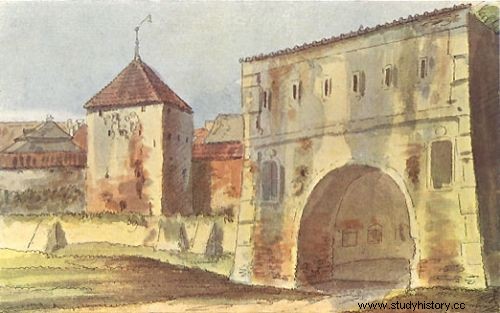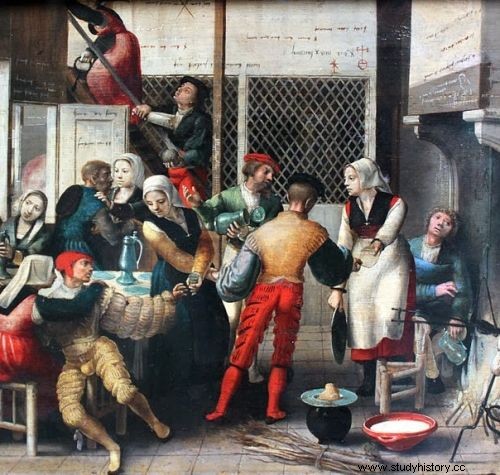b> - As for morality, I do not think that there is more freedom in Sodom and Gomorrah than in Krakow. Wherever you look, you will see an abundance of fornication. Wherever you go, a whole bunch of debauchees will follow you - wrote the Hungarian traveler Marton Csombor, who in 1618 visited the town of K
Was he exaggerating? Historian Andrzej Karpiński found in sources from the second half of the 16th and 17th centuries only 29 prostitutes in Kraków (for comparison 113 in Poznań, 15 in Lublin and 3 in Warsaw), but he relied mainly on court books. These are valuable sources, but very unreliable in the construction of various types of statistics. There had to be more prostitutes, which is already indicated by the sheer number of bribes.
When Csombor visited Krakow, there were 9 brothels in the city. Formerly it was believed that 13, but after careful research it turned out that two of them moved to a different address, and two more places were only visited by prostitutes in order to gain clients.
Legal and illegal riots
The most important brothel was the city brothel. At that time, cities in Poland benefited from fornication, having their own "licensed" establishments of this type. Usually "they were in the hands of the executioners, and their wives managed them" (Kamler, Villains , p. 161).
At the end of the 16th century in Krakow, such a city brothel was located in the Krakow Tower near the Reformed Church, later at the end of ul. st. Marka, and around 1604 at the exit of ul. Sienna, near the New Gate. In the second half of the 17th century, it was moved to ul. Szczepańska.

The New Gate at the end of Sienna Street. At the beginning of the 17th century, the official city brothel was located here.
In addition, illegal brothels operated, such as on Długa Street, which was managed by Jan Drygut at the turn of the 16th and 17th centuries. A few details are added by the invaluable Walerian Nekanda Trepka, who in his famous Book of Chums , a register of people usurping nobility, housed a few Krakow pimps. And for example around 1630 Jan Ceranowski lived in Podzamcze near Smocza Jama, who "hid for an inn" .
In turn, around 1617 Rokicki, another usurper of nobility, and his wife kept "skortisanki" in a house located behind the Mikołajska Gate. He was quite an efficient man, because when deputies to the Seym came to Warsaw, he would come there with his "loose whiteheads". Their clients were not only robbed but also killed, which forced Rokicki to flee Krakow.
In addition, individual harlotry flourished, and the places where customers were solicited were often Piwnica Świdnicka (as described by the scandalized Andrzej Frycz Modrzewski) and Smocza Jama (as written by the undisturbed Jan Andrzej Morsztyn).
"... I've been in prison eleven times ..."
Fornication was legal, and prostitutes were generally brought to trial for other reasons - most often theft. In 1598, a certain Agnieszka Korendówna from Kazimierz testified:"when she was a girl, she would take money from the peasants [...] what happened" (Kamler, Złoczyńcy , p. 174).
Sometimes they had to pay the amount due, for example in 1582 in Kazimierz, Neta of Tyniec, as she herself said, "she took a tin bowl from the canon for a night, because he gave me nothing" (Kamler, Villains , p. 175).

Brothel scene. The image of the so-called of the Brunswick monogrammer from 1540.
Pimps were punished for this. In 1597, Szczęsna Barwierka, who had lured a young girl into an inn, was whipped under the pillory and driven out of the city, and her ear was cut off. A year later, Jan Kucharz from Podlasie (or Jan, a cook from Podlasie) was tried for "deceiving little girls from town to town together with his wife" (Karpiński, Prostitution , p. 283).
Penalties did not always play a preventive role. Although the testimony of Magdalena Otwinowska, a prostitute active in Kraków and Kazimierz comes only from 1778, but they are quite characteristic:"I have already sat in prison in the Krakow Town Hall eleven times, and there I was punished in such a way [the dogwood was a bench on which the flogged people - ed. aut.] in front of the town hall, as pillory and ordained from the city "(Kracik, Rożek, Hultaje , p. 164).
The situation was absurd, because the executioner, who punished prostitutes, ran the brothel himself and more than once recruited among convicted women.
Limited harlotry or uncontrolled debauchery?
One would like to write a flashy sentence that the first brothel was established there immediately after the location of Krakow. Unfortunately, the lack of sources is an obstacle. It was only from 1398 that the information that the authorities of the capital city decided to close 3 brothels comes from. The idea was never implemented. It is worth remembering that in the Middle Ages, prostitution was treated as a normal profession. It has been argued that it is better to afford organized and limited harlotry than uncontrolled debauchery. The fact that such explanations were sought is not surprising given the scale of sexual crime in former Poland and Kraków.

Sleeping partners. 18th century engraving.
In 1655, the authorities of Kraków changed their minds and forbade renting flats to prostitutes and people benefiting from prostitution. Among the injured, there could even be a city lawyer Brzuchański, because there was information from 1650 that he was renting an apartment to "Duninowa Cymabaliścina and other harlot women".
It was not until the Enlightenment Age that more decisive action was taken. In 1783, the Police Department ordered the arrest of all "women with harlotry" in Krakow and sent them to public works. This solution also proved unsuccessful.
In the nineteenth century, harlotry was not so much fought as tried to control and regulate it. At the end of this century, one could hear the opinion that Krakow is "a city of priests, soldiers and prostitutes" (quoted in:Micińska, Zdrada , p. 87). And it stayed that way - at least until the outbreak of World War II.
Sources:
Basic
- Kamler Marcin, Villains. Crime in the Crown in the second half of the 16th century and in the first half of the 17th century (in the light of city court records) , Warsaw 2010.
- Karpiński Andrzej, Prostitution in large Polish cities in the 16th and 17th centuries (Kraków, Lublin, Poznań, Warsaw) , "Kwartalnik Historii Kultury Materialnej", R. 36, 1988, No. 2.
- Kracik Jan, Rożek Michał, Hultaje, villains, harlots in old Krakow , Krakow 1986.
Complementary
- Csobra Tibor, Marton Szepsi Csombor and his Europica Varietas , "Nowiny Płockie" 4 / 13-14, 1959.
- Micińska Magdalena, Zdrada, daughter of Noca. The concept of national treason in the minds of Poles in the years 1861-1914 , Warsaw 1998.
